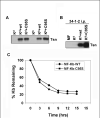Comparative analysis of the impact of a free cysteine in tapasin on the maturation and surface expression of murine MHC class I allotypes
- PMID: 19490214
- PMCID: PMC2753537
- DOI: 10.1111/j.1744-313X.2009.00840.x
Comparative analysis of the impact of a free cysteine in tapasin on the maturation and surface expression of murine MHC class I allotypes
Abstract
Tapasin is a key molecule in the major histocompatibility complex (MHC) class I peptide-loading complex, interacting with several other proteins in the complex. An amino acid substitution at a free cysteine position in tapasin has been shown to disrupt the covalent association of tapasin with ERp57. In this study, we mutated the free cysteine in mouse tapasin, and analysed the effects on the cell surface expression of the mouse MHC class I molecules K(d) and K(b). The C95S substitution in mouse tapasin increased the proportion of open forms relative to folded forms for both types of MHC class I molecules at the cell surface. Furthermore, the C95S substitution resulted in increased association of tapasin with folded K(d). Overall, our studies with these mouse MHC class I allotypes have revealed that the free cysteine 95 in mouse tapasin influences stable expression at the plasma membrane for both MHC class I allotypes, and have shown that tapasin's interaction with folded K(d) is elevated by the C95S substitution in tapasin.
Figures


Similar articles
-
Productive association between MHC class I and tapasin requires the tapasin transmembrane/cytosolic region and the tapasin C-terminal Ig-like domain.Mol Immunol. 2012 Jan;49(4):628-39. doi: 10.1016/j.molimm.2011.11.002. Epub 2011 Dec 12. Mol Immunol. 2012. PMID: 22169163 Free PMC article.
-
Influence of the tapasin C terminus on the assembly of MHC class I allotypes.Immunogenetics. 2009 Jan;61(1):43-54. doi: 10.1007/s00251-008-0335-x. Epub 2008 Oct 29. Immunogenetics. 2009. PMID: 18958466 Free PMC article.
-
Effect of a tapasin mutant on the assembly of the mouse MHC class I molecule H2-K(d).Immunol Cell Biol. 2010 Jan;88(1):57-62. doi: 10.1038/icb.2009.59. Epub 2009 Aug 18. Immunol Cell Biol. 2010. PMID: 19687800 Free PMC article.
-
The interface between tapasin and MHC class I: identification of amino acid residues in both proteins that influence their interaction.Immunol Res. 2002;25(3):261-9. doi: 10.1385/ir:25:3:261. Immunol Res. 2002. PMID: 12018464 Review.
-
Interaction of ERp57 and tapasin in the generation of MHC class I-peptide complexes.Curr Opin Immunol. 2007 Feb;19(1):99-105. doi: 10.1016/j.coi.2006.11.013. Epub 2006 Dec 5. Curr Opin Immunol. 2007. PMID: 17150345 Review.
Cited by
-
Analysis of major histocompatibility complex class I folding: novel insights into intermediate forms.Tissue Antigens. 2012 Apr;79(4):249-62. doi: 10.1111/j.1399-0039.2012.01849.x. Epub 2012 Feb 13. Tissue Antigens. 2012. PMID: 22329842 Free PMC article.
-
Productive association between MHC class I and tapasin requires the tapasin transmembrane/cytosolic region and the tapasin C-terminal Ig-like domain.Mol Immunol. 2012 Jan;49(4):628-39. doi: 10.1016/j.molimm.2011.11.002. Epub 2011 Dec 12. Mol Immunol. 2012. PMID: 22169163 Free PMC article.
References
-
- Deverson EV, Powis SJ, Morrice NA, Herberg JA, Trowsdale J, Butcher GW. Rat tapasin: cDNA cloning and identification as a component of the class I MHC assembly complex. Genes and Immunity 2001. 2001;2:48. - PubMed
-
- Dick TP, Bangia N, Peaper DR, Cresswell P. Disulfide bond isomerization and the assembly of MHC class I-peptide complexes. Immunity. 2002;16:87. - PubMed
-
- Farmery MR, Allen S, Allen AJ, Bulleid NJ. The role of ERp57 in disulfide bond formation during the assembly of major histocompatibility complex class I in a synchronized semipermeabilized cell translation system. Journal of Biological Chemistry. 2000;275:14933. - PubMed
-
- Garbi N, Tan P, Diehl AD, Chambers BJ, Ljunggren H-G, Momburg F, Hämmerling GJ. Impaired immune responses and altered peptide repertoire in tapasin-deficient mice. Nature Immunology. 2000;3:234. - PubMed
-
- Garbi N, Hammerling G, Tanaka S. Interaction of ERp57 and tapasin in the generation of MHC class I-peptide complexes. Current Opinions in Immunology. 2007;19:1. - PubMed
Publication types
MeSH terms
Substances
Grants and funding
LinkOut - more resources
Full Text Sources
Research Materials
Miscellaneous

